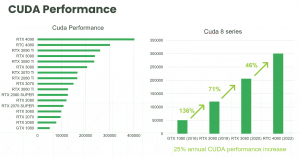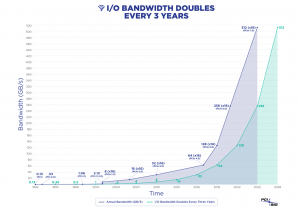Soon! Building rafts on Chia using a video card
Recently, the Chia team has been sharing very interesting news. The most recent of them is the creation of rafts on video cards using GPU. And this is a very, very fast way to create rafts for the Chia farm. For example, creating a k-32 raft (109 gigabytes) takes a minute and a half. But there are also nuances to the hardware, which we will talk about below.
Intro
GPU plotting is a very fast way to create Chia rafts. For example, for one graph on an RTX 3090, 4070ti video card passes in 80-90 seconds. This is half the time if we used the fastest and most modern processor from Intel Intel Xeon Scalable 4th generation (The price of the processor starts from $ 3000). A graphics video card is much more affordable for farmers than a processor.
The principle of operation of a graphics plotter is that it takes buckets — table, splits it into segments, similar to how plotters work on the CPU, and passes these segments to the GPU to perform the sorting, matching and compression functions necessary at the creation stages. Modern GPUs cope quite smartly with such tasks, the faster the GPU, the faster the calculation process.
The creation time depends on 2 things, the power of the video card and the bandwidth of the PCI Express bus (the Peripheral Component Interconnect Express bus for connecting peripheral devices to the computer motherboard). When using the classical method of creating rafts on the CPU, we are faced with a slowdown of several times. A narrow throat in insufficient memory for data because of this, you need to unload the data into a temporary file, write it to the hard disk.
Graphics processor performance
Graphics processors are getting faster with each generation due to an increase in the number of computing units and the energy efficiency of silicon itself. The top NVidia 4090 graphics cards of the latest generation have almost twice as much computing power as the 3090. Average productivity Growth (CARG) of about 25% per year statistics from 2016 to 2022.
PCI Express (PCIe) – as we said earlier, this is an input/output bus that is needed for the operation of devices that are connected to the mat. payment. To put it more simply, this is the network through which the motherboard devices, RAM, video card, CPU, etc. exchange data with each other. This direction also shows rapid growth rates. PCI-SIG expects PCIe bandwidth to double every 3 years. For example, now solid-state drives from CXL are switching to PCIe Express, which will give great opportunities to increase the cache memory, accelerators and network up to 400 GB /s. To date, PCIe 5.0, where the x16 channel, can provide data exchange speeds of up to 64 GB/s in each direction simultaneously, like several DDR5 memory channels.
An even cheaper and energy efficient way to build rafts.
The method of building rafts on video cards is 2.5 times more efficient than the coolest when working with the CPU and 5 times more efficient than building on simple SSD hard drives.
Example:
- AMD 5950X, PCIe 4.0 x16, 128GB DDR4, 2x 980 Pro NVMe, 3060Ti
- 265 wathour — when the plotter is running
- 4 minutes is the time to create a k32 raft size
- 31.4 TB/Day at 0.2kW per terabyte
- Replotting a 200TB farm will take about 7 days
- With standard plotting on hard drives, the same procedure would take 26.5 days.
Plot Grinding or Fake Chia rafts
You can start creating a raft after receiving signage points and try to complete the raft before the infusion point. This is described in detail on the Chia docs website. Then remove the raft after receiving a quality assessment (or after presenting proof if it meets the requirements). This would allow you to create rafts that automatically pass the filter, allowing you to engage in mining, without physical rafts. This becomes possible only if phase 1 of plotting can be completed in less than 28 seconds (before infusion). Although it’s not really an attack on the network that poses a security threat, it’s just an attempt to use computing resources instead of space. We call it “raft grinding” – fake rafts. The more fake rafts an attacker can make, the higher his chances of getting a reward.
Let’s say, for example, that we have infinite computing capabilities and perfect software efficiency, and we are limited only by PCIe bandwidth. To complete phase 1, you need to upload about 500 GB of data to the GPU and send about 360 GB back to the CPU. Thus, the theoretical limit for a PCIe 4.0 x16 card is about 20 seconds, and for a PCIe 5.0 x16 card it is 10 seconds. With POC (Proof of concept, PoC — proof of concept), we actually get about 24 seconds to transfer the amount of data required for Phase 1 on a GPU with PCIe 4.0 support.
Plot Filter – Raft Filter
Fake rafts in Chia — is an attempt to turn PoST into PoW. Fortunately, Bram foresaw this, and there are many constants in Chia to protect against this. The important constants selected in Chia are the block time, the minimum size k in the network, and the Plot Filter. The most important protection against counterfeiting rafts is to make it incredibly unprofitable and uneconomical, without harming honest farmers, requiring more resources and time to implement. Profitability is proportional to the raft filter! Reducing the size of the raft filter instantly makes forgery impossible for many years.
Constants in proof of space set in Chia
- Signage point time (seconds): 9.375
- Plot filter: 512
- K value minimum: 32
- IO Proof quality check: 9 read requests
- IO Full proof of space (and partial request from pool): 64 read requests
- Partials per day: set by pool operators, estimated at 300 for reference
- Average IO size per request (kB): 14
How the raft filter works in Chia mining:
- The farmer gets inVDF call
- Farmer sends signage point to harvester
- Harvester applies a raft filter to reduce the amount of I/O required on disk (1/512)
- For the sections that have passed the filter, harvester performs a proof quality check
- If the quality corresponds to the required iterations (depending on complexity), then get a complete proof of the space.
Total:
Creating a GPU plotter for the Chia network will give advantages to farmers. Now you can create rafts much faster, with low energy consumption costs, you will no longer need hard drives. Performance gain up to 5 times compared to CPU. GPU performance and I/O throughput are growing rapidly, and in the future GPUs will be able to perform the 1st phase of construction in less than 28 seconds, which makes it possible to fake rafts despite the fact that it is uneconomical/not profitable. However, the Chia blockchain has constants that prevent raft forgery, and we propose Filter Rafts — CHIP to further reduce the profitability of counterfeiting.



